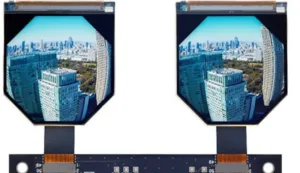I have made several times the argument that VR and AR hardware is limited in its development by the availability of VR and AR specific displays in high quantities. The logic behind this argument was that mass produced displays need a large application base to manufacture these displays cost effectively and recoup the necessary development cost. This week JDI has proven me wrong in this assumption.

They announced the mass production of a LCD display specifically designed for VR applications.
The panel is based on LTPS technology allowing for a higher refresh rate and response time and is using an IPS LCD switching mode specifically designed for VR.
JDI VR LTPS LCD panel
The new display has a diagonal size of 2.1” with a resolution of 1600×1600 pixels. This equates to a pixel density of 1058 ppi. While this not the highest pixel density of any display, it is pretty much up there for LCD panels. Micro displays have higher pixel densities, but JDI has closed the gap drastically. Up to now, Sony was leading the smartphone applications in pixel density with the Xperia 1 display sporting 643 ppi. Considering the relationship between Sony and JDI, one could assume that the Xperia 1 display was the predecessor of this new VR display. Of course the Xperia 1 display is much larger at 6.5” and comes with 3840×1644 resolution.
At the same time the new display comes with a refresh rate of 120Hz and a response time of 4.5ms (gray to gray, worst case). The brightness is rated at 430 cd/m². According to the JDI press release this new display not only increases resolution and refresh rate but will also reduce blur and latency. These are important features for VR headsets. So far, the conventional wisdom in the industry is that you need fast switching OLED panels to reduce VR sickness for the user.
The interesting statement from JDI is that this panel is already used in a headset introduced in the market. While they did not disclose what headset they were referencing, some analysts have been trying to guess what hardware platform JDI is referring to. UploadVR announced the JDI display as well and pointed their finger at Huawei’s VR glasses based on the small size and the display specification of the Huawei headset. The Germany based news outlet Mixed on the other hand points the finger at the Lynx R-1 headset as the first to adapt the JDI display. They actually state that this is confirmed by the founder of Lynx, Stan Larroque.
All in all, this is a very interesting development, as it marks a major display manufacturer developing a specific VR display. JDI is not necessarily the market leader in very small display manufacturing, but they have a good reputation and customer portfolio. While recent developments have not been kind to their bottom line, they seem to have secured a substantial infusion of money to keep the doors open for now. In some form this maybe a gamble from JDI to be the first in the market and establish a leadership position within the VR market. The interesting question is how many VR hardware manufacturers will jump ship and switch to a LCD panel in their new designs? -NH

